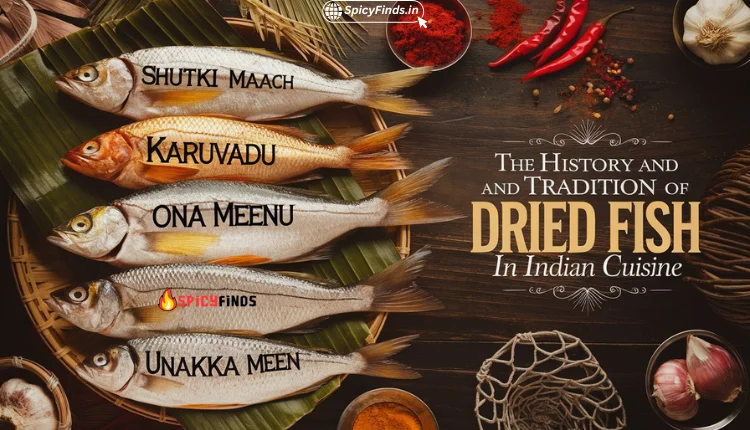- Your cart is empty
- Continue shopping

Dried fish has been a core ingredient in Indian cuisine for centuries, playing a crucial role in the country’s culinary heritage. This article explores the rich history, diverse traditions, and cultural significance of dried fish across India, from coastal regions to inland areas.
The Cultural Significance of Dried Fish in India
Ancient Origins and Preservation Techniques
The practice of drying fish in India dates back to ancient times. Coastal communities discovered that removing moisture from fish could extend its shelf life, making it an invaluable food source during lean seasons. This method of preservation was especially important before the advent of refrigeration.
Traditional Drying Methods
Sun drying is the most common technique used in India. Fish are cleaned, salted, and then spread out under the hot sun for several days. In some regions, fish are strung on lines and left to air-dry. These methods are still widely used today, especially in small-scale operations.
The Role of Salt
Salt plays a crucial role in the drying process. It draws out moisture from the fish, inhibiting bacterial growth and preserving the meat. This salting process also contributes to the unique flavor profile of dried fish.

Regional Varieties and Culinary Uses
India’s vast coastline and diverse climate have led to a wide variety of dried fish preparations across the country.
Tamil Nadu: Karuvadu
In Tamil Nadu, dried fish is called “Karuvadu.” It is a key ingredient in Tamil cuisine, used in spicy curries, chutneys, and stir-fries, and is often enjoyed with rice.
Karnataka: Ona Meenu/Vana Meenu
In Karnataka, dried fish is called “Ona Meenu” or “Vana Meenu.” It is commonly used in spicy curries and stir-fried dishes, often paired with rice for a flavorful meal.
Kerala: Unakka Meen
Kerala’s cuisine features several dried fish varieties, including “unakka meen” (dried fish) preparations that are often used in curries and stir-fries.
West Bengal: Shutki Maach
In Bengal, dried fish is known as “shutki” or “shuko maach.” It’s often used to enhance the flavor of vegetable dishes or prepared as a standalone dish with spices.
Maharashtra: Bombil
The Bombay Duck, locally known as Bombil, is a popular fish for drying in Maharashtra. It’s used in various dishes, including the famous Bombil fry.
Northeast India: Fermented Fish
In northeastern states like Meghalaya and Manipur, fermented fish is a delicacy. It’s used in dishes like “gudok” in Tripura and “eromba” in Manipur.
Nutritional Value and Health Benefits
Dried fish is not just a flavor enhancer; it’s also a nutritional powerhouse.
Rich in Protein
Dried fish is an excellent source of protein, making it a valuable food item, especially in regions where fresh meat might be hard to find.
Micronutrient Source
It’s rich in essential micronutrients like calcium, iron, and vitamin A, contributing to better nutrition in many communities.
Cultural Significance
Dried fish holds a special place in many Indian cultures, going beyond just a food item.
Festivals and Rituals
In some communities, dried fish plays a role in wedding rituals and festivals. For example, in Meghalaya’s Khasi community, dried fish is part of the wedding ceremony.
Economic Importance
The dried fish industry provides livelihood to many coastal communities, especially women who are often involved in the drying and selling process.
Modern Trends and Challenges
While dried fish remains popular, the industry faces several challenges in modern times.
Urbanization and Changing Tastes
As more people move to cities, traditional foods like dried fish are sometimes left behind. However, there’s also a growing interest in preserving these culinary traditions.
Quality Control and Food Safety
Ensuring proper hygiene and quality control in the drying process is crucial for food safety. Modern techniques are being introduced to improve these aspects.
With online shopping on the rise, even fresh and dried fish are sold online. As a trusted online seller of all dried seafoods, we prioritize hygiene, thoroughly checking and packing our dried seafood before delivery.
Environmental Concerns
Overfishing and climate change pose threats to the availability of fish for drying. Sustainable fishing practices are becoming increasingly important.
Cooking with Dried Fish
Dried fish can be used in various ways in the kitchen.
Rehydration
Before cooking, dried fish often needs to be soaked in water to rehydrate it. This process can take anywhere from 20 minutes to several hours, depending on the size and type of fish.
Popular Dried Fish Dishes
We have shared a vast collection of dried fish recipes in our dried fish recipes section, where you can explore various traditional and modern preparations. Here are some popular dried fish dishes from different parts of India with their regional names.
- Karuvadu Fry: A simple dish where dried fish is fried with spices.
- Bombil Bhujna: A spicy curry made with dried Bombay Duck, popular in Maharashtra.
- Shutki Maach Bhorta: A Bengali dish where dried fish is mashed with onions, garlic, and spices.
Buying and Storing Dried Fish
When purchasing dried fish, look for pieces that are completely dry and free from mold. Store in an airtight container in a cool, dry place to maintain freshness.
The Future of Dried Fish in Indian Cuisine
Despite challenges, dried fish continues to be an important part of Indian cuisine. There’s a growing interest in preserving traditional food practices, and dried fish is finding its way into modern, fusion cuisines as well.
Dried fish is more than just a food item in India; it’s a testament to the country’s culinary ingenuity and cultural diversity. From the sun-drenched coasts to the northeastern hills, dried fish continues to flavor dishes and lives across the nation.
As we move forward, preserving this tradition while adapting to modern needs will ensure that dried fish remains an integral part of Indian cuisine for generations to come.
